| | 2023-4-14
珍珠白陶器(Pearlware)是英国瓷器大家韦基伍德于1779年首先发明并使用的,是在1000到1100摄氏度中温情况下呈色的釉下青花或釉下五彩陶器,以黄蓝绿叁种颜色为主,在白胎瓷土上的氧化铅瓷釉里添加了少量的化学氧化钴蓝,使得烧成陶器的白地透明釉面,呈现一抹澹澹的青蓝色,这就更加接近中国早期外销瓷器所谓的紧皮亮釉白中泛青的亮青釉,因此又叫中国釉、珍珠白釉、或珍珠瓷釉。其他厂家,包括利兹,都是从威基伍德那儿学来的。
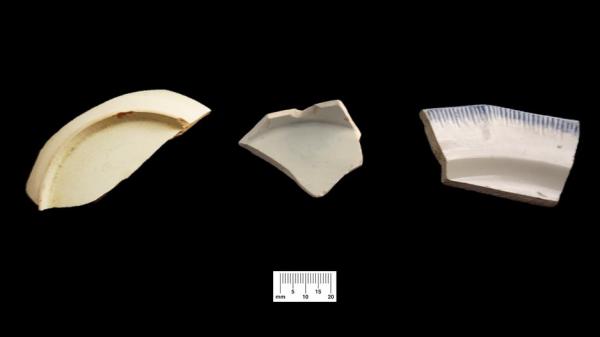
从左到右的英国瓷片釉色种类:奶黄釉、珍珠瓷釉、纯白釉
Pearlware is an earthenware made by Josiah Wedgwood in 1779. It was copied by other potters in England. Pearlware is only slightly different in color from creamware and for many years collectors have confused the terms. Only certain colors like blue, yellow, and green were used as underglaze paintings for pearlware because materials for other colors could not stand the heat necessary to fire the glaze.
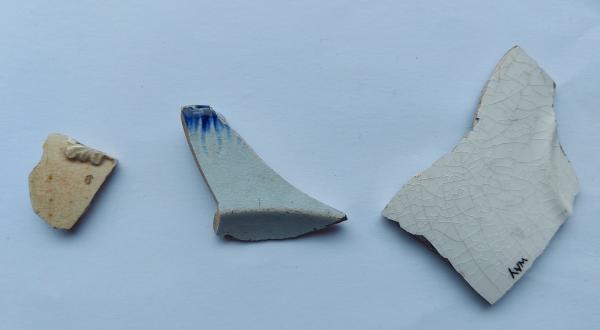
从左到右的英国瓷片釉色种类:奶黄釉、珍珠瓷釉、纯白釉
维多利亚博物馆收藏的利兹珍珠白陶器。
Thus the repertoire of colors for underglaze painting (which was the contemporary potters' term) was restricted to tin, lead, and antimony for yellow; cobalt for blue; lead and copper for greens. Iron and manganese oxide mixed produced brown tones; manganese alone gave a purplish brown; black was produced by a mixture of iron oxide and cobalt and orange by any of the yellow oxides with the addition of iron oxide.
两个英国早期珍珠白釉青花盘
最早期(1775-1781)的珍珠白陶器,以釉下青花为主,工笔细描,一丝不苟,以彷中国青花瓷器为主:
Blue was the dominant underglaze color for China glaze and the early pearlware from c. 1775 until around 1795. During this period, most of the blue painting was in a chinoiserie style. The development of underglaze printing in the mid-1780s appears to have played a role in limiting the painting of chinoiserie-style landscapes on tableware, but blue-painted China glaze teawares appear to have continued to be made until the period of the Napoleonic Wars when cobalt became scarce because supplies from Saxony and Norway were cut off by economic blockades. It appears that China glaze painted wares fell off in production as a result, suggesting an end date for them of around 1810.
到了1785-1815年,釉下彩绘出现,可是彩绘中没有青花:
The volatility of prices and problems with the supply of cobalt due to the Napoleonic Wars appear to have a relationship to the introduction and increased production of underglaze-painted polychrome wares that began appearing in the mid-1790s (and to the decline in blue-painted wares). Polychrome painted wares from the period c. 1795 to c. 1815 often do not have any cobalt blue in the patterns, or when it is present, it is rarely the dominant color. These wares used oxides of copper green, antimony yellow, iron brown, and manganese brown because they were often under a blue-tinted “pearlware”.
从1815年开始,到1830年为止,因为拿破仑战争的影响,浓墨重抹的釉下青花开始出现:
Following the end of the Napoleonic Wars, cobalt blue painted wares again became common. This period’s blue floral painted patterns with large brush strokes were unlike the earlier, smaller floral painted patterns. While there was a dramatic increase in the use of cobalt blue, there is very little evidence of chinoiserie-style painted patterns following the War of 1812. Their place seems to have been taken by the printed patterns, such as the blue willow and others in a Chinese style. Polychrome painted wares with an increasing use of cobalt blue from c. 1815 to 1830. Later in this period, the amount of blue tinting declined as whiteware was being developed.
到了1830年以后,因为化学元素铬的发现和硼砂的应用,包括红黄绿和青花在内的釉下多彩,才成为珍珠白或者奶黄釉陶器的主流。
The introduction of borax into the glazes facilitated the use of chrome colors - greens, reds, and yellows - that became common after 1830 in the Staffordshire potteries. Chrome was identified as an element in 1798 by the French chemist Louis Nicolas Vauquelin. The metal was given the name chrome because of the variety of colors that could be derived from it. The earliest recorded use of chrome as a ceramic colorant was as a green ground on Sevres porcelain in 1802 (Préaud and Ostergard 1997:154), but it was not common on refined earthenwares until around 1830. One of the prominent new chrome colors was red (actually more of a pinkish red), made with chrome oxides in combination with alkaline glazes using borax. Because underglaze red and pink colors were not available until chrome oxides were introduced, they become excellent tpq indicators for the post-1830 period. Black became a common color for stems in floral painted wares from the 1830s on through the rest of the century.
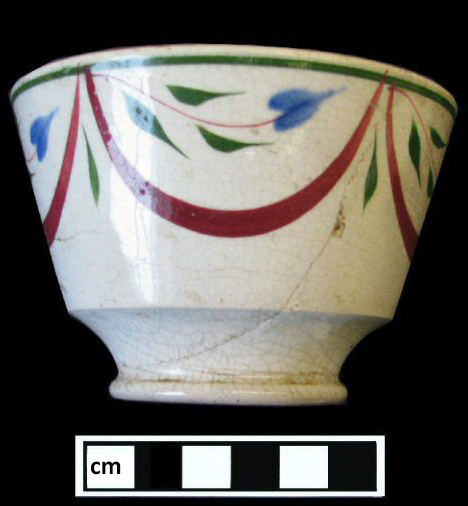
| 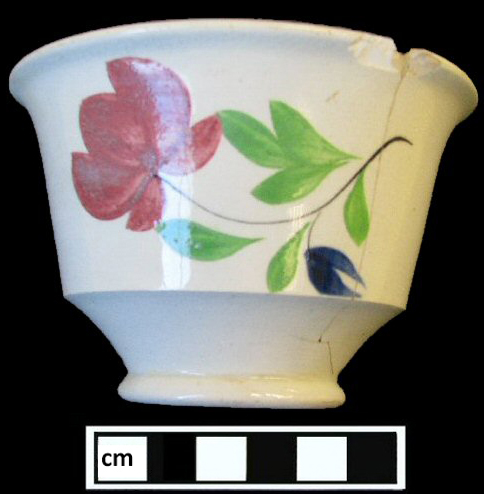 |
到1835年以后,一直到1870年,英国瓷器厂为了节省成本,降低价格,一种细小碎花的彩绘图桉开始呈现,代替了笔画繁复耗费颜料的早期珍珠白彩绘技术。
The earliest painted patterns, such as the China glaze landscapes, required a skilled painter and a large number of brush strokes, and thus were more expensive to produce. As the prices for painted wares fell, the potters were looking for ways to cut production costs. One of the ways to do this was the simplification of the painted patterns. By c. 1835, sprig patterns were being introduced. These were very simple small floral painted patterns that only required four-to-six short brush stokes for each element. Sprig-painted wares remained common up into the 1870s and possibly later.
1810-1820年间出口到北美新大陆的釉下彩陶又称Gaudy Dutch。是英国借助日本伊万里瓷器风格而开发出来的十六种彩绘图桉。
This style of polychrome hand-painted refined earthenware is also known as Gaudy Dutch. It can occur on a background of pearlware or creamware, however, the dates are currently thought to be the same for both.
美国佛罗里达大学博物馆收藏的英国珍珠白釉瓷片
White to light cream-colored, thin, hard, refined earthenware paste. White to faint bluish-white clear lead glazed background, caused by the addition of cobalt to the glaze. There is a bluish cast where the glaze pools. Delicately painted floral wreath designs in olive green, brown, blue, and mustard yellow. If the motif occurs on creamware, the background is pale creamy yellow. We usually refer to any ceramics with the blue-tinted glaze as pearlware, an adaptation of Wedgwood’s pearl white, but some may refer to pearlware with a Chinese-style decoration as China glaze.

波士顿考古学会列出的各种颜色釉
The ceramic vessels consisted of both vessels used for the production and storage of food as well as serving food. Tablewares and teawares included creamware, pearlware, whiteware, redware, ironstone plates, bowls, cups, and saucers used for settings during meals and tea service. Ceramic vessels used for food production and storage included creamware, ironstone, pearlware, redware, stoneware, whiteware, and yellowware. The redware and stoneware were the most prevalent production/storage vessels due to their lack of expense.
顾名思义,奶黄釉微微发黄,而且黄中泛一点点的绿,也是威基伍德引入实用的,可是存在的时间应该更早一些,在1740年前后,是在以氧化铅为主的釉水中加入了氧化铜才产生的,威基伍德改进了配方,在胎体和釉水中都添加了瓷石,使釉色更白更亮,称之为女王釉。等到珍珠瓷釉发明并进入正规生产之后,奶黄釉就澹出了市场。
上面四个瓷器,左边两个是奶黄釉,右边两个是珍珠白釉,又称中国釉。
Creamware, the earliest of the three, was formally introduced in England by Josiah Wedgwood in 1762. Cream-colored wares were being produced as early as the 1740s, but Wedgwood succeeded in creating a more refined ware. Wedgwood coined this ware as Queen’s Ware after completing his commission for Queen Charlotte in 1765 (Wedgwood Museum 2016). The creamy color seen in the glaze is achieved by the addition of copper to a lead oxide glaze. In places where the glaze pools, such as a footring, the glaze will look almost green. The popularity of creamware began to decline around 1800 with the introduction of pearlware and is virtually non-existent after 1820.
按理说奶黄釉和珍珠白釉,都是可怜的英国人为了在瓷器生产上弯道超车而多走了的弯路,不像那些聪明的德国人,利用工业间谍盗取了景德镇的瓷器配方而一步到位,后来发现瓷釉中添加钴料,一是需要增加生产成本,得不偿失,二是发现钴矿中,含有大量的砷杂质也就是毒药砒霜,会引发采矿工人和制瓷工人的职业病。于是才改邪归正,像德国的梅森学习,直接烧制纯白瓷了。
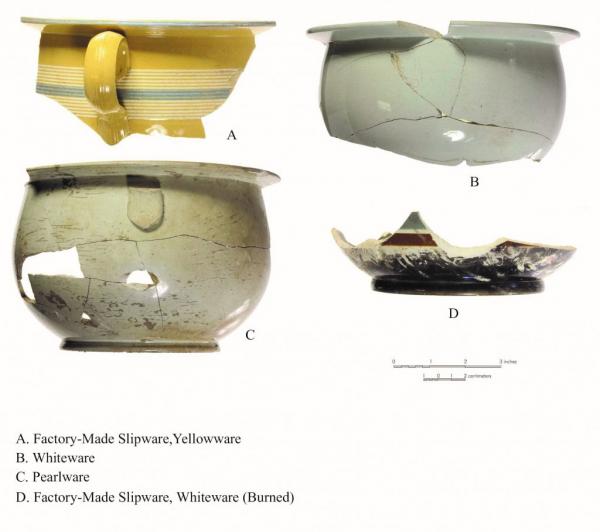
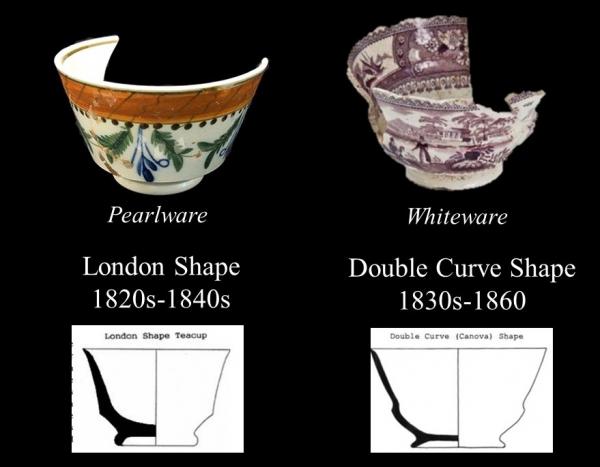
珍珠白釉和纯白釉瓷器的对比

英国瓷器中的釉色变化:奶黄釉1762-1800、珍珠白釉1775-1840、纯白釉1820-至今。
Over time the use of cobalt decreased, most likely due to the expense of obtaining the mineral. Fun fact: the word cobalt is derived from the German word kobalt, which means goblin. Cobalt ore, when smelted, produces a powder that contains arsenic, which is highly toxic. By around 1808 a fully whitened version of creamware (known as White Ware) was introduced to meet changing market demand. As the use of cobalt decreased, whiteware begins to emerge, approximately around 1820. During the transition between pearlware and whiteware, it can sometimes be difficult to determine the difference between the two. Early whitewares can have a slightly blue hue to the glaze, particularly in areas where the glaze is thicker. Sometimes we define this as transitional whiteware.
失去了颜色釉的陶瓷,就回复到了梅森瓷器的高冷和一枝独秀,也失去了日用瓷的地方特色、多元化和竞争力。于是乎,进入二十世纪之后,曾经不可一世,兴盛了两百五十多年的英格兰瓷器制造业,也已经日薄西山,纷纷倒闭,关门大吉了。
参考文献:
|
